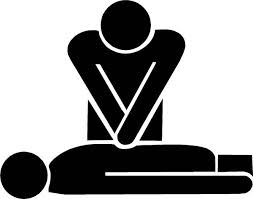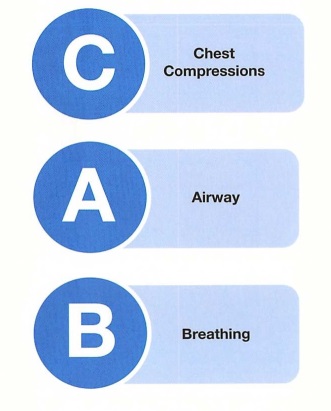Before you begin
Survey the scene to ensure the surrounding area is safe for the rescuer as well as the victim. Note: unless there is an imminent danger, the victim should not be moved. Assess the surroundings for any people who can help.
Observation is extremely important in an effort to understand the reason for sustained injury: automobile accident, electric shock, fall, fire, etc.
Before starting CPR, check:
- Is the person conscious or unconscious?
- If the person appears unconscious, tap or shake his or her shoulder and ask loudly, "Are you OK?"
- If the person doesn't respond and two people are available, one should call 911, and one should begin CPR.
- If you think the person has become unresponsive because of suffocation (such as from drowning). In this special case, begin CPR for one minute and then call 911.
- If an AED is immediately available, deliver one shock if instructed by the device, then begin CPR.
CAB
The acronym of CAB - circulation, airway, breathing - is a good way to remember the order to perform the steps of CPR.
Breathing: Breathe for the person
Rescue breathing can be mouth-to-mouth breathing or mouth-to-nose breathing if the mouth is seriously injured or can't be opened.
- With the airway open (using the head-tilt, chin-lift maneuver), pinch the nostrils shut for mouth-to-mouth breathing and cover the person's mouth with yours, making a seal.
- Prepare to give two rescue breaths. Give the first rescue breath - lasting one second - and watch to see if the chest rises. If it does rise, give the second breath. If the chest doesn't rise, repeat the head-tilt, chin-lift maneuver and then give the second breath.
- Resume chest compressions to restore circulation. Thirty chest compressions followed by two rescue breaths is considered one cycle.
- Continue compressions and breaths -- 30 compressions, two breaths -- until help arrives.
Children ages 1 - 8
The procedure for giving CPR is essentially the same as that for an adult. The differences are as follows:
- If you're alone, perform five cycles of compressions and breaths on the child - this should take about two minutes - before calling 911.
- Use only one hand to perform heart compressions.
- Breathe more gently.
- Use the same compression-breath rate as is used for adults: 30 compressions followed by two breaths.
Infants
Most cardiac arrests in babies occur from lack of oxygen, such as from drowning or choking. If you know the baby has an airway obstruction, perform first aid for choking. If you don't know why the baby isn't breathing, perform CPR. If you're the only rescuer and CPR is needed, do CPR for two minutes - about five cycles - before calling 911 or your local emergency number. If another person is available, have that person call for help immediately while you attend to the baby.
Circulation: Restore blood circulation
- Place the baby on his or her back on a firm, flat surface, such as a table. The floor or ground also will do.
- Imagine a horizontal line drawn between the baby's nipples. Place two fingers of one hand just below this line, in the center of the chest.
- Gently compress the chest about 1.5 inches.
- Count aloud as you pump in a fairly rapid rhythm. You should pump at a rate of 100 compressions a minute.
Airway: Clear the airway
- After 30 compressions, gently tip the head back by lifting the chin with one hand and pushing down on the forehead with the other hand.
- In no more than 10 seconds, put your ear near the baby's mouth and check for breathing: Look for chest motion, listen for breath sounds, and feel for breath on your cheek and ear.
Breathing: Breathe for the infant
- Cover the baby's mouth and nose with your mouth.
- Prepare to give two rescue breaths. Use the strength of your cheeks to deliver gentle puffs of air (instead of deep breaths from your lungs) to slowly breathe into the baby's mouth one time, taking one second for the breath. Watch to see if the baby's chest rises. If it does, give a second rescue breath. If the chest does not rise, repeat the head-tilt, chin-lift maneuver and then give the second breath.
- If the baby's chest still doesn't rise, examine the mouth to make sure no foreign material is inside. If the object is seen, sweep it out with your finger.
- If the airway seems blocked, perform first aid for a choking baby.
- Continue compressions and breaths -- 30 compressions, two breaths -- until help arrives.


